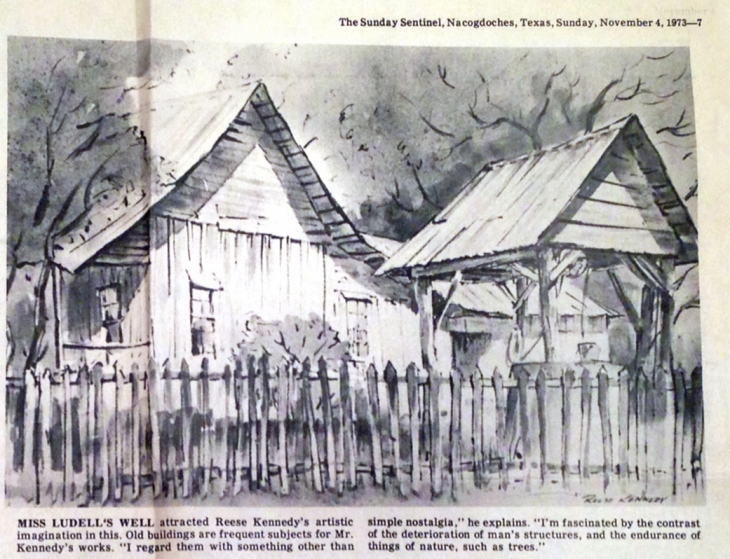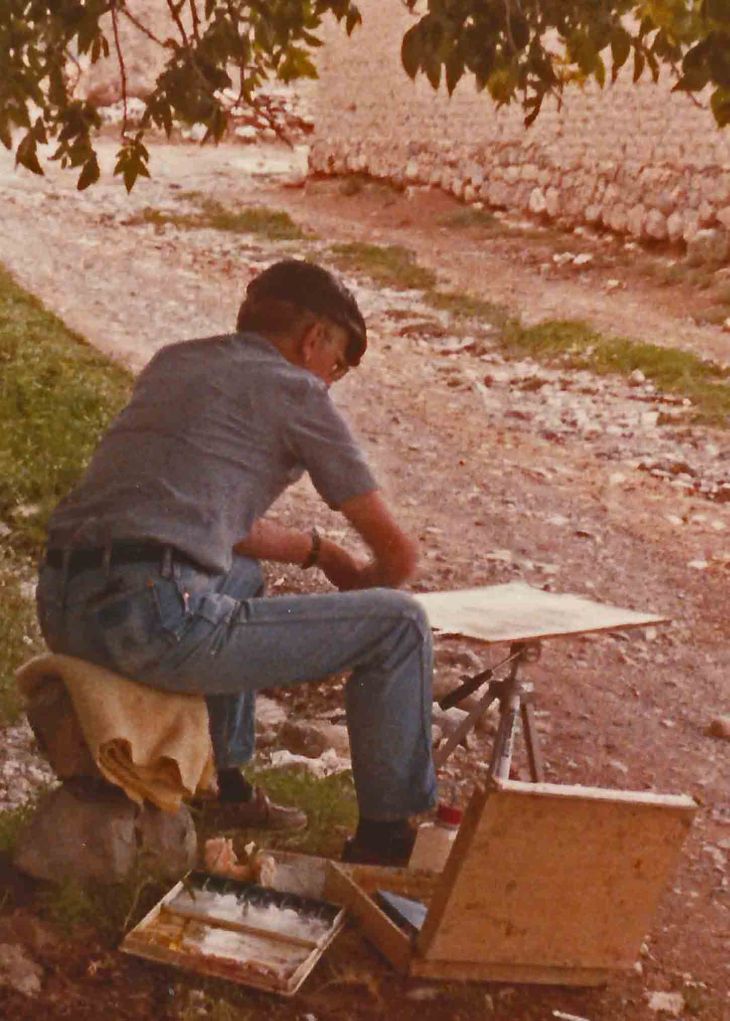Sharpening Saws and Shaping Beliefs
Sometimes memories seem to slip up on us and shake us by the arm saying, “Remember this? It was important! You learned a lot more than you realized at the time.” Here’s the story of just such a memory. It has influenced my thinking about teaching and learning in ways more profound and relevant to my practice as an educator than any number of graduate classes.
When I was twelve years old my grandfather, Arch Warnock (AKA Grampie), taught me how to sharpen saws during a summer visit in Smackover, Arkansas. He found an old saw blade in his shop that I couldn’t harm, loaded me up in his 1957 Chevy, and drove me to the local hardware store. He told the owner of the store he needed a saw handle because his grandson was going to learn to sharpen saws. He attached the handle and showed me how to tighten the blade into place on a rack behind his shop.
Then he went to work showing me how to use a tool to set the points of the saw. Alternating points had to be accurately set which meant I had to pay attention and not miss one. After setting the points, he taught me how to read the points and set my file. Consistently holding the file at the proper angle and moving it in a straight line were difficult skills for this twelve year old student. He placed his hands on mine and led me through the process, never expressing frustration at my faulty and sometimes clumsy first attempts. Gradually he let me take over while he continued to coach and make adjustments.
Then came the hard part…PRACTICE! He would leave me to work on my saw and then return in an hour or so. He tested my work by cutting a quarter inch piece off of a two-by-four. After a few quick strokes and a look at the saw blade, he’d scrape the tips off of the whole saw with two sweeps of a large flat file. This meant it was not cutting correctly and I would have to do the whole saw again. After watching me file and making suggestions, he’d leave me to my work.
This went on for several days during which I gradually gained some confidence, skill, and blistered fingers. I finished sharpening the saw for what seemed like the 75th time; now for the big test. As my grandfather made the first few strokes with the saw, I noticed a smile forming around the mouthpiece of his pipe. He sawed clean through the wood in a few smooth strokes, stood back and declared, “That saw will cut!”
I’ve never forgotten the pride I felt as my grandfather proclaimed the saw would cut; that saw I sharpened would cut! This was an early taste of real self-esteem, the result of struggling to learn something new and coming out on the other side with the ability to perform a task that seemed impossible in the beginning.
My grandfather did the following:
1. He gave me a clear goal and made it relevant to a real world problem.
2. He set a high standard and believed I could meet it.
3. He coached and encouraged me while giving honest feedback about my performance.
4. He gave me opportunity to practice in a hands-on way.
5. He showed unconditional love for me regardless of my skill and celebrated my success.
I did not make a career of sharpening saws, but I think Arch Warnock would be pleased that his grandson is a school principal and that those lessons in sharpening a saw have shaped my beliefs and influence my work to this day. When I see students succeeding because of the work we do in our school, I sometimes imagine my grandfather looking on from a distance and saying with a smile, “That saw will cut!”
“CAN You Draw a Texas Longhorn?”
Yesterday I was reminded that January 4 would have been my Uncle Reese’s 90th birthday. He was my mother’s older brother and she loved him very much. As a child, I was in awe of him because he was an artist. As an adult, I was in awe of him because of his adventurous spirit, his open questioning mind, and his talent.
When I was 5-years old we were visiting Uncle Reese and his family in Dallas. For reasons I can’t recall, I was obsessed with Texas Longhorns. Shortly after we arrived I approached Uncle Reese as the adults were visiting and asked if he would draw me a picture of a Texas Longhorn. He said he’d do this later and continued to visit with my parents.
I approached my uncle several more times over the next day or two and each time he was polite but probably assumed his five-year-old nephew would become obsessed with something else if he delayed.
My mother tells me that I finally approached my uncle and asked clearly, “Uncle Reese, CAN you draw a Texas Longhorn?” He quietly got up and led me to his art studio where I watched in amazement as he made a Texas Longhorn appear before my eyes with ink and chalk. He then signed it “TEXAS LONGHORN drawn for Jim Warnock, Thanksgiving 1960, Reese Kennedy.”
This hangs on the wall of my living room today and I treasure the memory of that one-on-one time with my uncle as I watched him produce this drawing.
I’m not sure that this early success at getting my Uncle Reese to do what I wanted him to do predicted my future work in education or administration but he and his family definitely shaped my thoughts about the place of Fine Arts in education. I view the arts as central to learning. They are not optional but an essential part of any effective curriculum.
I’m thankful for my Uncle Reese and only regret that we were not able to spend more time with him and his family.
Additional historical note: Four years after this event, Reese Kennedy founded, and was the first president of, the Southwest Watercolor Society. This association of artists continues to this day.
April, 2016: Thank you to one of Reese’s former students for sharing the following newspaper clippings. He also shared the following comments about his memory of Reese.
Reese was one of my heroes. I only have three heroes so this is a sincere complement. The other two heroes are my dad and my high school football coach, the two heroes that sent me to SFA on a football scholarship in 1965. On arrival to SFA, I visited the art department and had a short conversation with Reese. I was sold immediately on signing up in his classes, not sure of which ones, but that is not important as I sooner or later took all of them. I was hooked on his personality and charm, not to mention his love for the arts and water coloring quest for excellence. – Mike Mikulenka




What Should We Fear?
“Aren’t you afraid of the bears?” This is a question I’m often asked. It’s usually followed by, “And what about the snakes?” I’m far from fearless, but bears and snakes do not even make my top five when backpacking.
Here are my wilderness fears in priority order.
1. Dehydration
2. Heat exhaustion
3. Hypothermia
4. Bee stings or tick bites
5. Falls (especially at creek crossings)
Fear is a good motivator and can keep us out of trouble, but irrational fear can only paralyze. I know someone (an excellent teacher) who will not step foot into the woods because of fear. She is sure that bears and snakes are hiding behind trees, ready to attack. While I’m respectful of bears and don’t sleep with a raw steak in my tent, I would consider it a treat to see an Arkansas black bear at a reasonable distance. I was once enjoying a freshwater spring and noticed a snake a few feet away curled up in the leaves. I decided to move quietly down the trail, but the image of that beautiful copperhead made the hike memorable.
Like my friend’s obsessive fear of wildlife, I think we educators sometimes fear the wrong things. I’d like to retrieve those sleepless nights caused by my irrational fears. Are we ready for Standards Review? What if we worded some ACSIP actions incorrectly? What if I don’t pass Phase II of TESS? I could go on, but you get the idea. Obsessing on these areas didn’t solve anything. In some cases, they distracted me from more important areas that impact students.
As an educator, here are a few legitimate fears I have (in no particular order):
1. Spending time and energy on the wrong things.
2. Overlooking or missing students who are in need.
3. Making a mistake when hiring a new teacher.
4. Failing to help those around me grow professionally and personally.
5. Reaching a point where I’m not learning and growing.
Preparation and planning can make a difference when facing legitimate fears. Want to avoid dehydration in the woods? Pack a water filter and study your map to see where water sources are along your route. Sometimes route adjustments are necessary to avoid water shortages while hiking. The same holds true as an educator. We must prepare and make adjustments based on things that matter.
If I fear spending time and energy on the wrong things, then I should work with my staff so that we base actions on priorities and evidence. I must learn to prune out actions that don’t move students and teachers forward. I should speak up for AAEA legislative positions that help us avoid directives that take away from the essential work of teaching and learning.
If I fear that I might fail to help those around me grow professionally, I should involve staff in preparing their professional learning to ensure that it is relevant to their professional growth plans. We must ensure that adult learning facilitates children’s learning. I can make my teachers’ professional learning a priority and recognize their growth.
Being involved in the AAEA can alleviate my fear of becoming stagnant in my own professional learning. I’m often surprised when I trace an effective action back to its beginning and realize it was based on something I learned while networking with peers through the AAEA, and my two constituent organizations.
We’re all motivated by fear to some extent, and that’s probably healthy. Will we be paralyzed by irrational fear, hunkering down and hoping for the best? If we’re motivated by legitimate fears that will negatively impact students and teachers, then thoughtful actions could reduce those fears and help us all move in positive directions. We might also get a better night’s sleep.
The above was written for the January 2014 issue of The Administrator newsletter published by the Arkansas Association of Educational Administrators.







